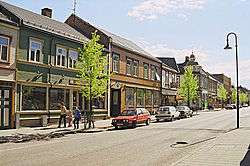Levanger (town)
| Levanger | |
|---|---|
| Town | |
|
Kirkegata, the main street. | |
 Levanger Location in Nord-Trøndelag | |
| Coordinates: 63°44′44″N 11°18′07″E / 63.74556°N 11.30194°ECoordinates: 63°44′44″N 11°18′07″E / 63.74556°N 11.30194°E | |
| Country | Norway |
| Region | Trøndelag |
| County | Nord-Trøndelag |
| District | Innherred |
| Municipality | Levanger |
| Area[1] | |
| • Total | 4.93 km2 (1.90 sq mi) |
| Population (2013)[1] | |
| • Total | 9,256 |
| • Density | 1,877/km2 (4,860/sq mi) |
| Time zone | CET (UTC+01:00) |
| • Summer (DST) | CEST (UTC+02:00) |
Levanger is a town and the municipal center of Levanger municipality, Norway. Prior to 1962, the town and its immediate vicinity was its own municipality. The 4.93-square-kilometre (1,220-acre) town has a population (2013) of 9,256, giving the town a population density of 1,877 inhabitants per square kilometre (4,860/sq mi).[1]
History
The town of Levanger was founded by Carl III, king of Sweden on 18 May 1836, on the site where the village of Levanger already existed. The village had expanded from the traditional winter fair, known as the marsimartnan (lit. the St. Marcus Market of Levanger), dating back to the 13th century. In October 1836, as the town's borders set, Commissioner Mons Lie proposed that "the town shall bear the name of Carlslevanger, so the name of this ancient soil can be united with that of the new town's glorious founder". Despite the suggestion getting refused, the town protocols spoke of Carlslevanger Stad instead of Kjøpstaden Levanger until 1838. In 1838, the formannskapsdistrikt law classified this town as a ladestad or port town.
The inhabitants of Levanger were not prepared at becoming a town, and so it took a long time before the town was constituted. In these early days the town was ruled by the Foged (Royal rural administrator). At that time there were already established a trade organization, "Levangerpatrisiatet" from 1695, based on the market. But only citizens of Trondheim could be members, until Levanger became a town in its own right. In 1839, the first guild of the town was established, and in the following years several new trades and craftsmen settled in the town.
In 1841, the first official elections were held, and Hans Nicolai Grønn was elected the first mayor of the town. Two years later, the town got its first water pipe system, its first two primitive street lamps and a town hall.
The fire-security report of 1844 clearly confirmed the great risk of disastrous fire in the town's narrow lanes; all houses were wooden houses. Therefore the mayor hired major Johannes Sejersted to make a general report and draw up a new regulation plan, showing levanger as a more "continental" town. And already in 1846, two years later the town was nearly totally ruined by a great fire. Sejersteds regulation plan was used when the town was rebuilt. Levanger has been damaged by two great fires after that time; in 1877 and 1897, but each time the town has been rebuilt as a wooden town, and still today most houses are wooden houses.
Throughout the 19th century, the famous market's economical importance faded out, and the ancient arrangement was reduced to a tradition without much content. That was the end of Levanger as an important port of foreign trade between Sweden and Norway. However, in the early 20th century, the town of Levanger was pleased by new establishments such as county hospital and college of education. The German occupation in 1940 was the beginning of a 40-year-long "interregnum" of the traditional "Marsimartnan".
In 1961, the town of Levanger decided to merge with its neighbors. On 1 January 1962, Frol, Skogn, and Åsen were merged with Levanger, and at the same time, it lost its "town status". The municipality of Ytterøy was merged with Levanger two years later.
Over thirty years later, in 1997, as a result of the resurrection of the "Marsimartnan" in 1989, the town of Levanger was re-established, though the town still is part of Levanger municipality. But the center of administration is to be found in the town of Levanger, which is also, in historical terms, the administrative basis for the municipality. The town is laid out according to an urban and regulated plot with proper streets such as Kirkegata. It's more than just a townhall and a city square. In fact, Levanger's always been a town, though not always officially, and every inhabitant in the town area carry this piece of knowledge with pride. Thus there does exist a sense of distinction between town people, and the people from the country side.
In 2002, Levanger joined the Cittaslow movement, although there have been some violations of the Cittaslow charter, of which can be mentioned the construction of the unharmonic new mini mall in Sjøgata, down by the seaside. This mini mall includes the post office, a grocery store and an electrical appliances store.
References
| Wikimedia Commons has media related to Levanger (town). |
- 1 2 3 Statistisk sentralbyrå (1 January 2013). "Urban settlements. Population and area, by municipality.".
